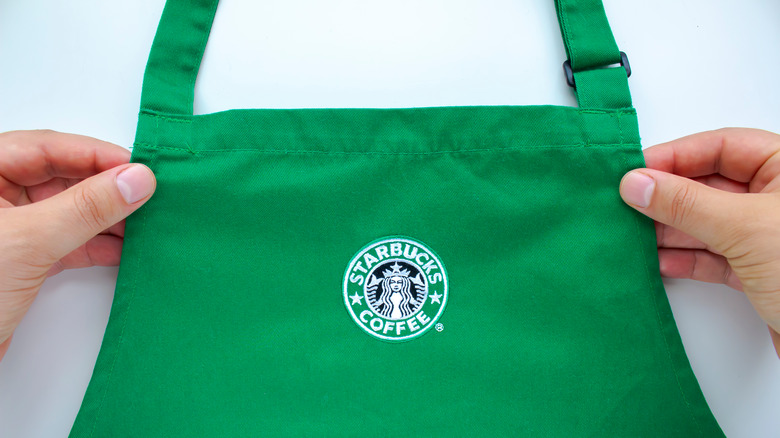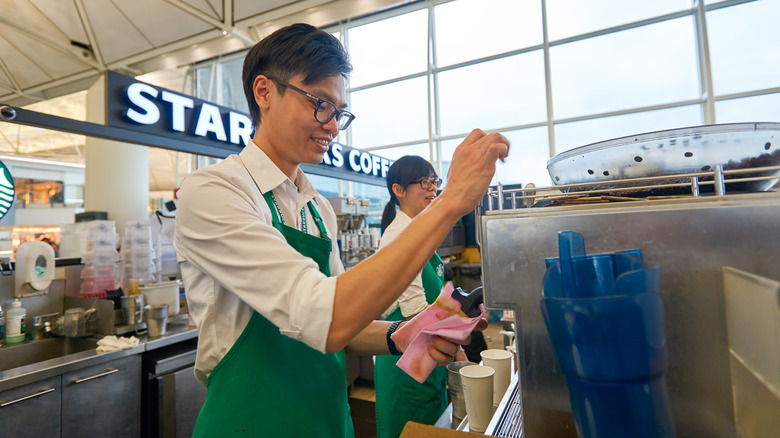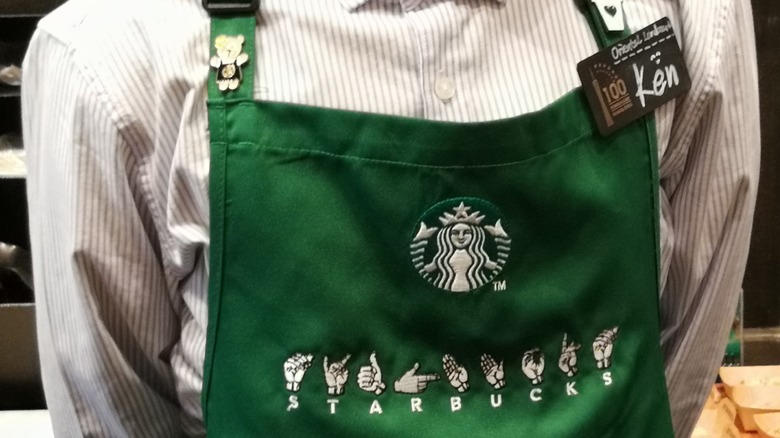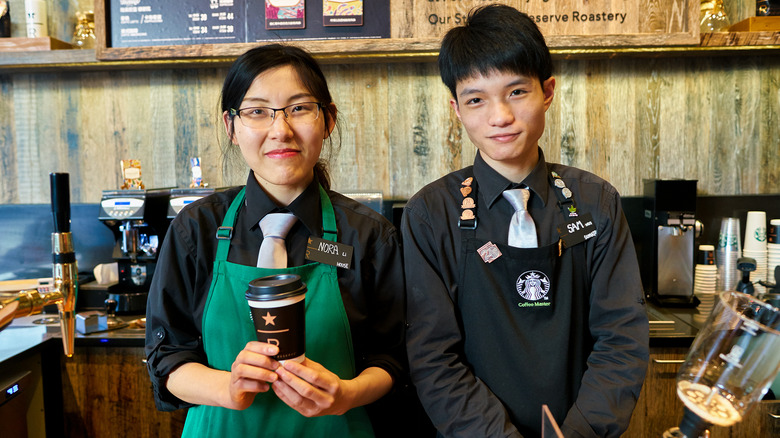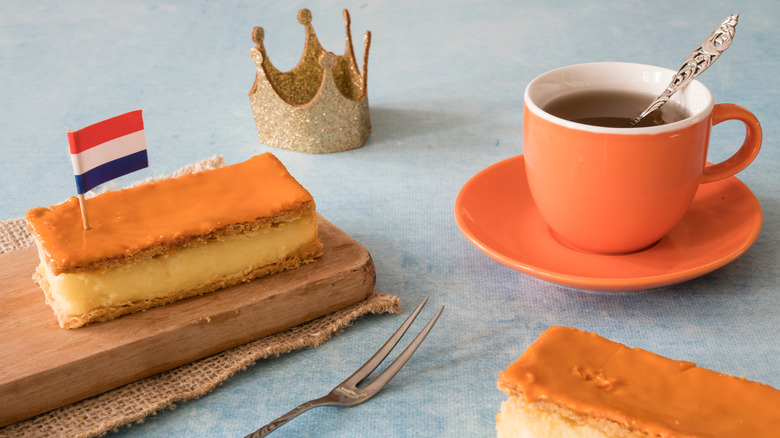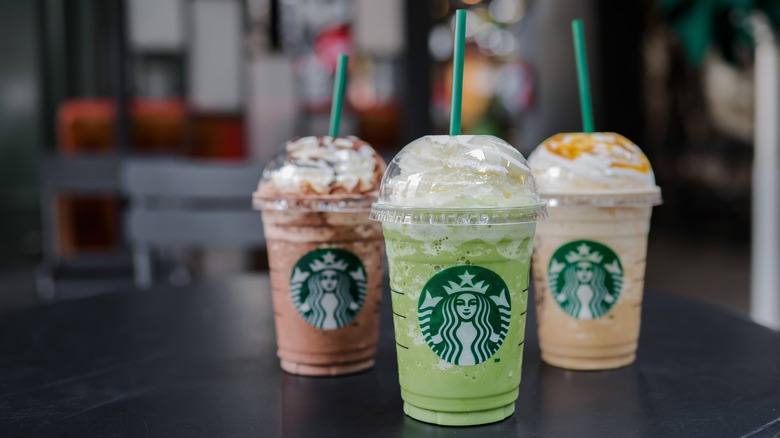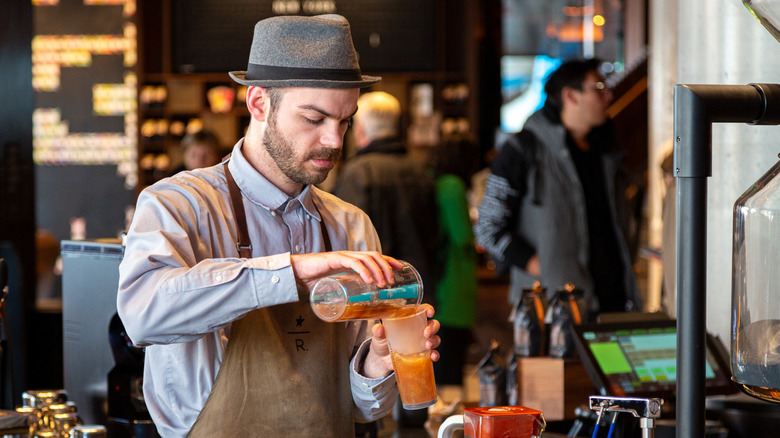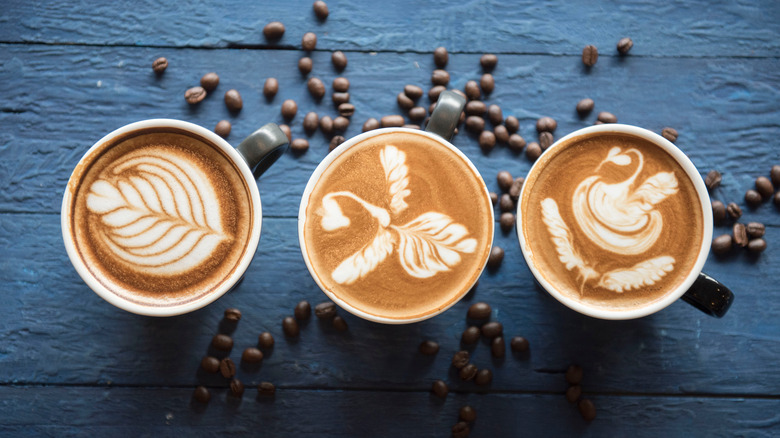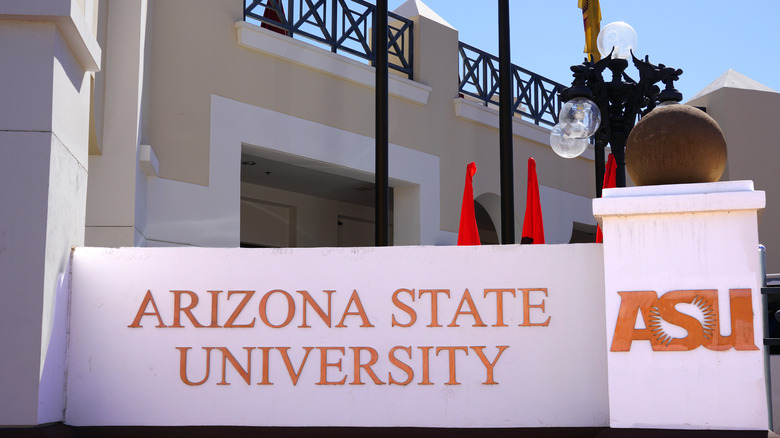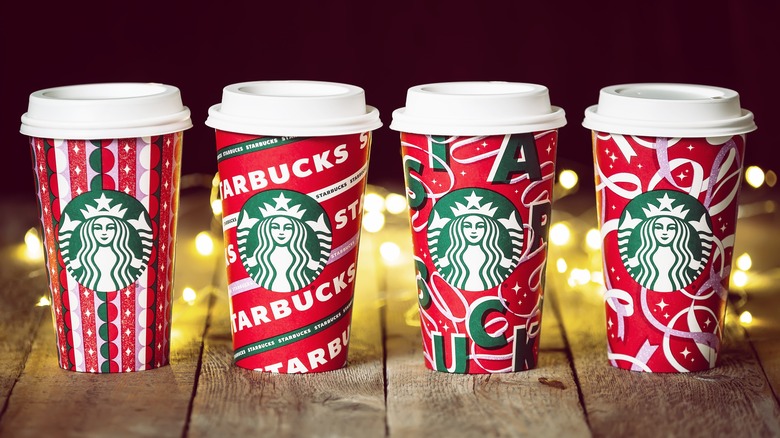What The Different Colored Starbucks Aprons Mean
DreamWorks' "Shrek 2" introduced audiences to the kingdom of Far Far Away, where modern businesses are given either a fairytale or a medieval makeover. During the film's climax, terrified citizens fled from an establishment called Farbucks and ran across the street to another Farbucks location.
While some of the children watching this movie might not make the connection, most adults will get the reference to Starbucks. After all, as Reuters has pointed out, Starbucks has more than 34,300 licensed and company-operated stores throughout the world. So, while it's unlikely you'll find two Starbucks directly across the street from one another, if you travel to places like Europe, the Middle East, Japan, the Caribbean, Canada, China, Latin America, Asia Pacific, or just within the United States, there's an excellent chance you'll find a Starbucks where apron-clad baristas are ready to take your order.
Now, if you're a regular Starbucks customer, you might have noticed that baristas don't always wear the same color aprons. In fact, you might find (for example) that the person who made your coffee and was wearing a green apron one week is now wearing a red one or an embroidered one. Like many successful businesses, this is not random but a deliberate choice that gives you helpful information.
Green Apron
Of course, the apron that pops into most people's minds when they think of Starbucks is the classic green apron. In fact, it wouldn't be unrealistic to say the green apron is as synonymous with Starbucks as its iconic siren logo. But that wasn't always the case.
According to the Starbucks website, the very first aprons worn at Starbucks when the first location opened in 1971 were brown aprons. Over the next 16 years, Starbucks expanded to 17 locations. But it wasn't until 1987 that Starbucks decided to change its look, mimicking Italian coffeehouses where patrons could order handcrafted beverages. This meant not only changes to the stores (like playing jazz or classical music), but also changes to the employees' "uniforms." Besides wearing white shirts and black bow ties, anyone working at Starbucks donned green aprons instead of brown ones.
Today, you probably won't see Starbucks baristas wearing black bow ties. This is because in 1992, the company became a public company, and they relaxed the dress code a bit (via Starbucks). "We wore our green apron with white, black and khaki," said Michelle Dougherty, who was a Starbucks barista in the 1990s. But even with this change, the green apron remained the standard one for this growing coffee chain.
Green Aprons with ASL Fingerspelling
As Starbucks has continued to expand its business, it's also tried to meet its customers' needs better. Case in point, it currently has 10 signing stores where its baristas are fluent in American Sign Language (ASL) via Starbucks. But how can you tell if a Starbucks location is a signing store? Well, a big clue is on the baristas' aprons.
Although you'll see green aprons at signing stores, as the Starbucks website explains, baristas at these locations which are deaf have embroidered aprons that spell out the word "Starbucks" in ASL. But the apron isn't the only difference you might notice at a Starbucks signing store. For example, take the first one that opened in the United States. Besides specials, you'll probably see posted a "sign of the week," which shows the ASL sign for a word, according to ABC News. And if you're not fluent in sign language, don't worry. Customers visiting this location have the option of using tablets when ordering.
Besides details like embroidered aprons and tablets, Starbucks chose to open its first U.S. signing store near Gallaudet University, which is a school for students who either have partial hearing loss or are deaf, per ABC News. Actress Marlee Matlin supported the signing store in person and on Twitter. Recently, Matlin was in the film "CODA," which told the story of Ruby, a Child of Deaf Adults (via IMDb). "CODA" won the 2022 Oscar for Best Picture (per Oscar.com).
Black Apron
While Starbucks trains all of its baristas, if you get one wearing a black apron, you're in especially good hands. Why? Because these aprons are only given to baristas who have completed the Coffee Master program (via Starbucks).
To discuss the Coffee Master program, we need to talk about Starbucks Coffee Academy, which the Starbucks website explains is an education program currently available in 60 countries. Current course offerings for this program are three to five hours long and cover various coffee-related topics like how to best brew coffees, the different flavors and aromas, and ways to blend coffee, per Starbucks Global Academy. The courses also explore the history of growing and processing coffee and current ethical sourcing practices. Students of the program can also learn about crafting espresso drinks and how coffee growing methods vary from country to country.
Besides the areas covered in these courses, a barista who completes the Starbucks Coffee Master program sometimes has the opportunity to visit the Starbucks coffee farm in Costa Rica, per Starbucks. However, before asking a black apron-wearing barista about Costa Rica, remember that not every Coffee Master makes this trip. With that said, if you're not sure which flavor of coffee is right for you, they'll probably be able to give you some guidance.
Orange Apron
One of the areas of the world where you can find Starbucks is the Netherlands (via Starbucks). And if you happen to visit Starbucks there in April, you might find that the baristas are wearing orange aprons instead of the standard green ones. And, no, it's not in honor of pumpkin spice lattes but as part of the country's King's Day celebration.
King's Day is in honor of King Willem Alexander's birthday, April 27. Given that the Dutch royal family is the House of Oranje (also sometimes called the House of Orange-Nassau or House of Orange), the color orange is the national color of Holland and a hallmark of this celebration. In fact, it's common to wear orange wigs, makeup, and/or clothes for King's Day, so Starbucks baristas can get into the spirit by donning orange aprons.
Besides wearing orange, a King's Day tradition is toasting the king with a type of liqueur known as Orange Bitter or Oranjebitter, according to Holland.com. And, as the name suggests, this beverage is a bright orange color, continuing the orange theme of the celebration. Other traditions of King's Day include flea markets and parties. Plus, the royal family visits at least one city for this holiday.
American Flag Embroidered Apron
It's common to see people wearing an American flag pin, for example, on the Fourth of July. However, you might see Starbucks baristas with an American flag on their aprons even if it isn't a national holiday. According to the Starbucks website, if an employee has a spouse in the military, they can wear an apron embroidered with an American flag and their spouse's name and military affiliation.
This idea began when more than one Starbucks employee expressed that they wanted to do something to honor their and other baristas' connections to the military (via Starbucks). This idea hit home for Tim Bomke, who was not only a former officer in the Army but also a senior product manager for Starbucks Technology Services. "I thought about my wife being a Starbucks barista when I was in Iraq and wondered what would have made her feel acknowledged for her sacrifices, too," he said. It was Bomke who created the first military affiliation apron in honor of his wife.
In addition to these unique aprons, the Starbucks Support Center in Seattle has a wall of silver medallions etched with the names of employees who are veterans or military spouses, per Starbucks. This Honor Wall (as it's called) goes back to 2013 and, by 2015, had more than 5,500 names on it.
Pale Blue Apron
When you hear the phrase "Happy Hour," chances are the first thing that comes to mind is probably a bar or at least beverages like beer, mixed drinks, or alcohol in general. And that's perfectly understandable, but the definition of Happy Hour has expanded over the years. For instance, according to the Starbucks website, Starbucks launched a Frappuccino Happy Hour during which baristas wore light blue aprons.
Although this special Happy Hour isn't a weekly occurrence, it's something to keep an eye out for especially if you're a fan of Frappuccinos. As Bustle has pointed out, the Frappuccino Happy Hour that ran from May 3 to May 15 in 2016, featured half price Frappuccinos if you ordered them between 3:00 p.m. and 5:00 p.m. And yes, in this case, half price means no matter what size or flavor, as long as the drink is a Frappuccino, customers got it half price. In addition, the event gave Starbucks a chance to introduce customers to a new Frappuccino, the Caramel Waffle Cone Frappuccino. Plus, the patrons could order an item brought back to the menu that spring, the S'mores Frappuccino.
Besides drink specials, May 2016's Frappuccino Happy Hour encouraged happy customers to tweet about their experience. As Bustle explains, when customers used the hashtag #FrappuccinoHappyHour, their tweet would have a Frappuccino emoji.
Tan Canvas Apron
Even though Starbucks replaced their original brown aprons with green ones in 1987 (via Starbucks), that doesn't mean you won't see tan aprons in a modern Starbucks. According to the Starbucks website, these tan canvas aprons with leather straps are only worn by Starbucks Reserve and Roastery employees.
Just as a winemaker might have a special reserve of their best wines, the Starbucks Reserve is the company's most exclusive coffee selection, according to the Starbucks Reserve website. The company experiments with how they brew, blend, infuse, and even age their coffees, developing new creations available only at their Roasteries and coffee bars. As a matter of fact, the tan aprons being made of canvas and featuring leather straps aren't just a fashion choice. No, as the Starbucks website explains, these aprons were "created to withstand years of labor and care needed for the art of roasting."
While there are Starbucks worldwide, Roastery locations (as highlighted on the Starbucks Reserve website) are Chicago, Milano, New York, Seattle, Shanghai, and Tokyo. And even if you're not near any of these places, the website also features a "Find a location" option that allows visitors to find Starbucks coffee bars featuring Reserve beverages.
Purple Apron
There's a chance you could go into a hundred different Starbucks locations worldwide and not see a single employee wearing a purple apron. This is because these aprons are only given to barista champions, making them one of the rarer aprons on this list (via Starbucks).
The story of the Starbucks purple apron began in London, where, according to the Starbucks website, Starbucks has its Europe, Middle East, and Africa (EMEA) headquarters. If it wasn't for this HQ, the Starbucks Barista Championship might have never existed. In 2019, the competition had grown to include baristas from 30 nations, each chosen as their country's National Champion.
In the 2019 Starbucks Barista Championship, the baristas competed against one another for two days, beginning with tests of their knowledge about Starbucks coffee and their skills in crafting coffee beverages, per Starbucks. By the final competition, the 16 remaining baristas would create latte art, using steamed milk to give a beverage an extra decorative touch. But we're not done yet. The latte art portion would only eliminate 12 of the competitors. A panel of experts would then select the winner from the remaining four.
Mortarboard Embroidered Apron
We've all scene graduation caps (a.k.a. mortarboards). At the end of the school year, proud families sometimes put up signs with pictures of graduation caps on the front of their houses to celebrate someone graduating from middle school, high school, or college. And suppose you guessed that a Starbucks barista wearing an apron embroidered with a mortarboard means they're a graduate. In that case, you'd be absolutely right—specifically regarding the Starbucks College Achievement Plan (via Starbucks).
Through a partnership with Arizona State University, Starbucks offers its employees the Starbucks College Achievement Plan's CAP Scholarship (per Arizona State University). Between this scholarship and the plan's Starbucks Tuition Benefit, employees who are undergraduates can have 100% of their tuition covered per semester. The plan also takes into account need-based federal aid grants and fees outside of tuition. This plan doesn't cover the costs of books and other school supplies, but the website notes that the tuition coverage has helped most employees offset these expenses.
While the Starbucks College Achievement Plan usually only applies to the Starbucks employee, there is one notable exception. According to Arizona State University, veteran Starbucks employees can extend their plan's benefits to cover one family member.
Red Apron
Let's face it. You're guaranteed to see red when the holiday season is upon us. Not in the figurative sense (although holiday stress can be frazzling). No, the color red is found in many traditional Christmas decorations like candy canes and holly berries. And let's not forget a certain little reindeer's nose is red and helps light the way for Santa, who usually wears a red suit. But Santa isn't the only one dressing in red during the holiday season.
According to the Starbucks website, employees switch to a red apron once the holiday season starts. You might think, "But wait, green is also associated with Christmas, and the main apron at Starbucks is green." Yes, that's true; from evergreens, which are commonly used for Christmas trees, to Dr. Seuss' green-furred Grinch, green is also a very common color at Christmastime. And as Starbucks told Mashed, green wasn't absent in 2021 from one of the company's holiday traditions—cups with special holiday designs.
As Mashed explained, Starbucks released four different holiday cups in 2021. The themes were "wrapping paper," "holiday lights," "ribbon," and "candy cane." And while each cup had a combination of four colors (red, green, white, and lilac), red was the most used and prominent color on these cups.
